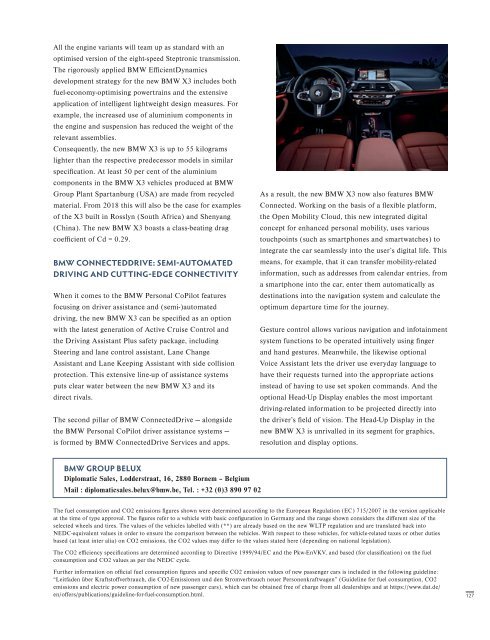You also want an ePaper? Increase the reach of your titles
YUMPU automatically turns print PDFs into web optimized ePapers that Google loves.
All the engine variants will team up as standard with an<br />
optimised version of the eight-speed Steptronic transmission.<br />
The rigorously applied BMW EfficientDynamics<br />
development strategy for the new BMW X3 includes both<br />
fuel-economy-optimising powertrains and the extensive<br />
application of intelligent lightweight design measures. For<br />
example, the increased use of aluminium components in<br />
the engine and suspension has reduced the weight of the<br />
relevant assemblies.<br />
Consequently, the new BMW X3 is up to 55 kilograms<br />
lighter than the respective predecessor models in similar<br />
specification. At least 50 per cent of the aluminium<br />
components in the BMW X3 vehicles produced at BMW<br />
Group Plant Spartanburg (USA) are made from recycled<br />
material. From 2018 this will also be the case for examples<br />
of the X3 built in Rosslyn (South Africa) and Shenyang<br />
(China). The new BMW X3 boasts a class-beating drag<br />
coefficient of Cd = 0.29.<br />
BMW CONNECTEDDRIVE: SEMI-AUTOMATED<br />
DRIVING AND CUTTING-EDGE CONNECTIVITY<br />
When it comes to the BMW Personal CoPilot features<br />
focusing on driver assistance and (semi-)automated<br />
driving, the new BMW X3 can be specified as an option<br />
with the latest generation of Active Cruise Control and<br />
the Driving Assistant Plus safety package, including<br />
Steering and lane control assistant, Lane Change<br />
Assistant and Lane Keeping Assistant with side collision<br />
protection. This extensive line-up of assistance systems<br />
puts clear water between the new BMW X3 and its<br />
direct rivals.<br />
The second pillar of BMW ConnectedDrive — alongside<br />
the BMW Personal CoPilot driver assistance systems —<br />
is formed by BMW ConnectedDrive Services and apps.<br />
As a result, the new BMW X3 now also features BMW<br />
Connected. Working on the basis of a flexible platform,<br />
the Open Mobility Cloud, this new integrated digital<br />
concept for enhanced personal mobility, uses various<br />
touchpoints (such as smartphones and smartwatches) to<br />
integrate the car seamlessly into the user’s digital life. This<br />
means, for example, that it can transfer mobility-related<br />
information, such as addresses from calendar entries, from<br />
a smartphone into the car, enter them automatically as<br />
destinations into the navigation system and calculate the<br />
optimum departure time for the journey.<br />
Gesture control allows various navigation and infotainment<br />
system functions to be operated intuitively using finger<br />
and hand gestures. Meanwhile, the likewise optional<br />
Voice Assistant lets the driver use everyday language to<br />
have their requests turned into the appropriate actions<br />
instead of having to use set spoken commands. And the<br />
optional Head-Up Display enables the most important<br />
driving-related information to be projected directly into<br />
the driver’s field of vision. The Head-Up Display in the<br />
new BMW X3 is unrivalled in its segment for graphics,<br />
resolution and display options.<br />
BMW GROUP BELUX<br />
<strong>Diplomatic</strong> Sales, Lodderstraat, 16, 2880 Bornem – Belgium<br />
Mail : diplomaticsales.belux@bmw.be, Tel. : +32 (0)3 890 97 02<br />
The fuel consumption and CO2 emissions figures shown were determined according to the European Regulation (EC) 715/2007 in the version applicable<br />
at the time of type approval. The figures refer to a vehicle with basic configuration in Germany and the range shown considers the different size of the<br />
selected wheels and tires. The values of the vehicles labelled with (**) are already based on the new WLTP regulation and are translated back into<br />
NEDC-equivalent values in order to ensure the comparison between the vehicles. With respect to these vehicles, for vehicle-related taxes or other duties<br />
based (at least inter alia) on CO2 emissions, the CO2 values may differ to the values stated here (depending on national legislation).<br />
The CO2 efficiency specifications are determined according to Directive 1999/94/EC and the Pkw-EnVKV, and based (for classification) on the fuel<br />
consumption and CO2 values as per the NEDC cycle.<br />
Further information on official fuel consumption figures and specific CO2 emission values of new passenger cars is included in the following guideline:<br />
“Leitfaden über Kraftstoffverbrauch, die CO2-Emissionen und den Stromverbrauch neuer Personenkraftwagen” (Guideline for fuel consumption, CO2<br />
emissions and electric power consumption of new passenger cars), which can be obtained free of charge from all dealerships and at https://www.dat.de/<br />
en/offers/publications/guideline-for-fuel-consumption.html.<br />
127


















